TESLA MODEL S 2012 Owner Safety Information
Manufacturer: TESLA, Model Year: 2012, Model line: MODEL S, Model: TESLA MODEL S 2012Pages: 28, PDF Size: 2.9 MB
Page 11 of 28
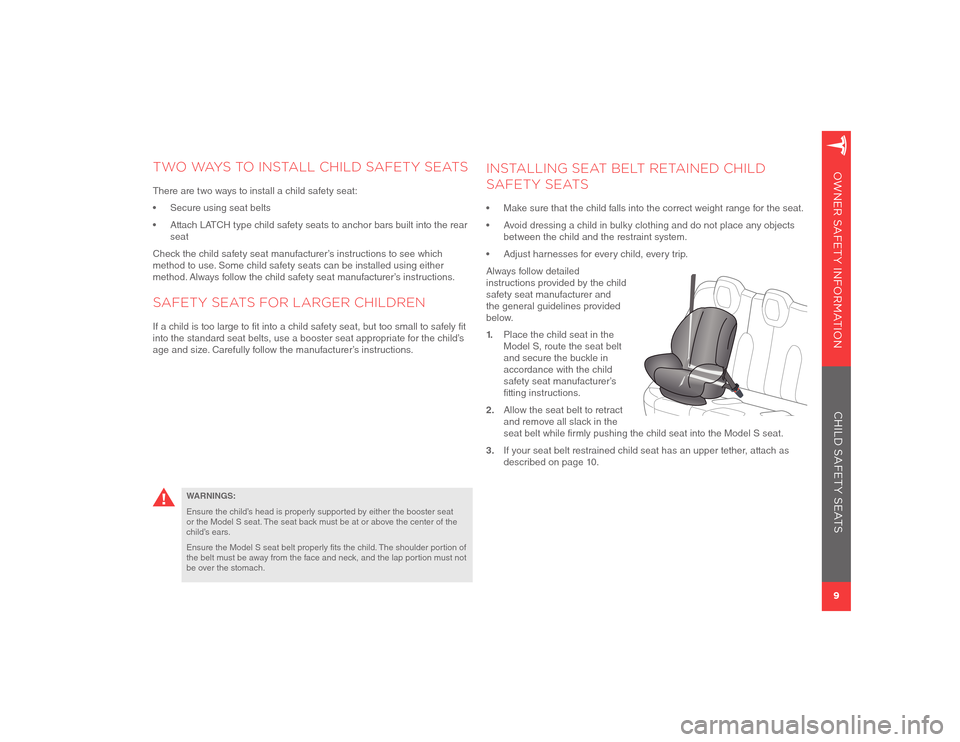
9OWNER SAFETY INFORMATION
TWO WAYS TO INSTALL CHILD SAFETY SEATSThere are two ways to install a child safety seat:
• Secure using seat belts
• Attach LATCH type child safety seats to anchor bars built into the rear
seat
Check the child safety seat manufacturer’s instructions to see which
method to use. Some child safety seats can be installed using either
method. Always follow the child safety seat manufacturer’s instructions.SAFETY SEATS FOR LARGER CHILDRENIf a child is too large to fit into a child safety seat, but too small to safely fit
into the standard seat belts, use a booster seat appropriate for the child’s
age and size. Carefully follow the manufacturer’s instructions.
INSTALLING SEAT BELT RETAINED CHILD
SAFETY SEATS• Make sure that the child falls into the correct weight range for the seat.
• Avoid dressing a child in bulky clothing and do not place any objects
between the child and the restraint system.
• Adjust harnesses for every child, every trip.
Always follow detailed
instructions provided by the child
safety seat manufacturer and
the general guidelines provided
below.
1. Place the child seat in the
Model S, route the seat belt
and secure the buckle in
accordance with the child
safety seat manufacturer’s
fitting instructions.
2. Allow the seat belt to retract
and remove all slack in the
seat belt while firmly pushing the child seat into the Model S seat.
3. If your seat belt restrained child seat has an upper tether, attach as
described on page 10.
WARNINGS:
Ensure the child’s head is properly supported by either the booster seat
or the Model S seat. The seat back must be at or above the center of the
child’s ears.
Ensure the Model S seat belt properly fits the child. The shoulder portion of
the belt must be away from the face and neck, and the lap portion must not
be over the stomach.
CHILD SAFETY SEATS
Page 12 of 28
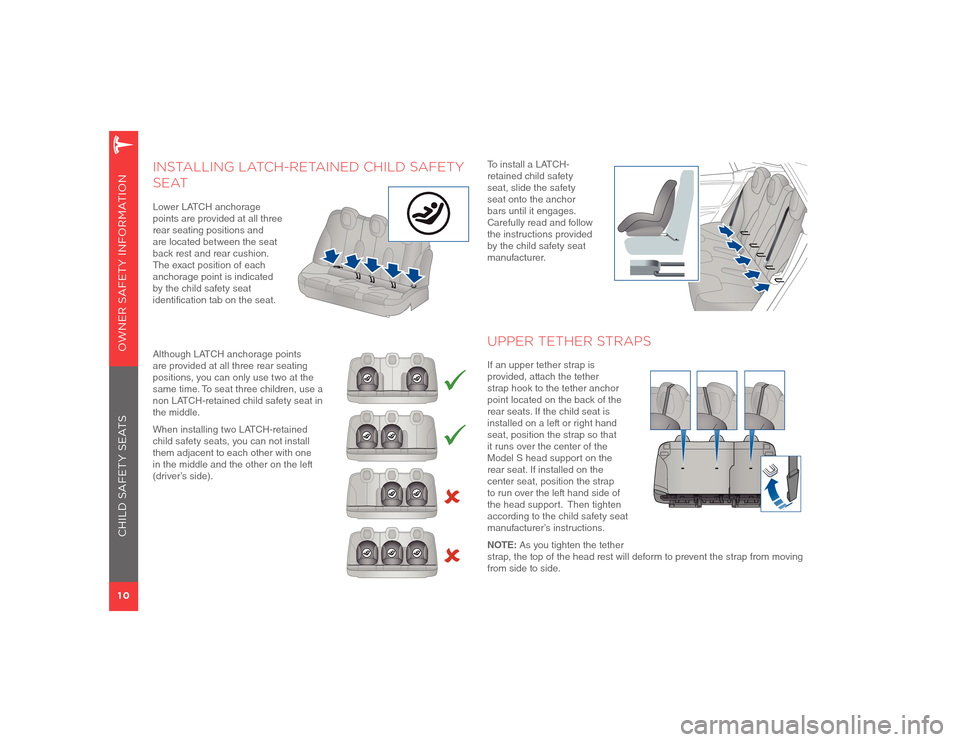
10OWNER SAFETY INFORMATIONCHILD SAFETY SEATS
INSTALLING LATCH-RETAINED CHILD SAFETY
SEATLower LATCH anchorage
points are provided at all three
rear seating positions and
are located between the seat
back rest and rear cushion.
The exact position of each
anchorage point is indicated
by the child safety seat
identification tab on the seat.
Although LATCH anchorage points
are provided at all three rear seating
positions, you can only use two at the
same time. To seat three children, use a
non LATCH-retained child safety seat in
the middle.
When installing two LATCH-retained
child safety seats, you can not install
them adjacent to each other with one
in the middle and the other on the left
(driver’s side). To install a LATCH-
retained child safety
seat, slide the safety
seat onto the anchor
bars until it engages.
Carefully read and follow
the instructions provided
by the child safety seat
manufacturer.
UPPER TETHER STRAPSIf an upper tether strap is
provided, attach the tether
strap hook to the tether anchor
point located on the back of the
rear seats. If the child seat is
installed on a left or right hand
seat, position the strap so that
it runs over the center of the
Model S head support on the
rear seat. If installed on the
center seat, position the strap
to run over the left hand side of
the head support. Then tighten
according to the child safety seat
manufacturer’s instructions.
NOTE: As you tighten the tether
strap, the top of the head rest will deform to prevent the strap from moving
from side to side.
Page 13 of 28
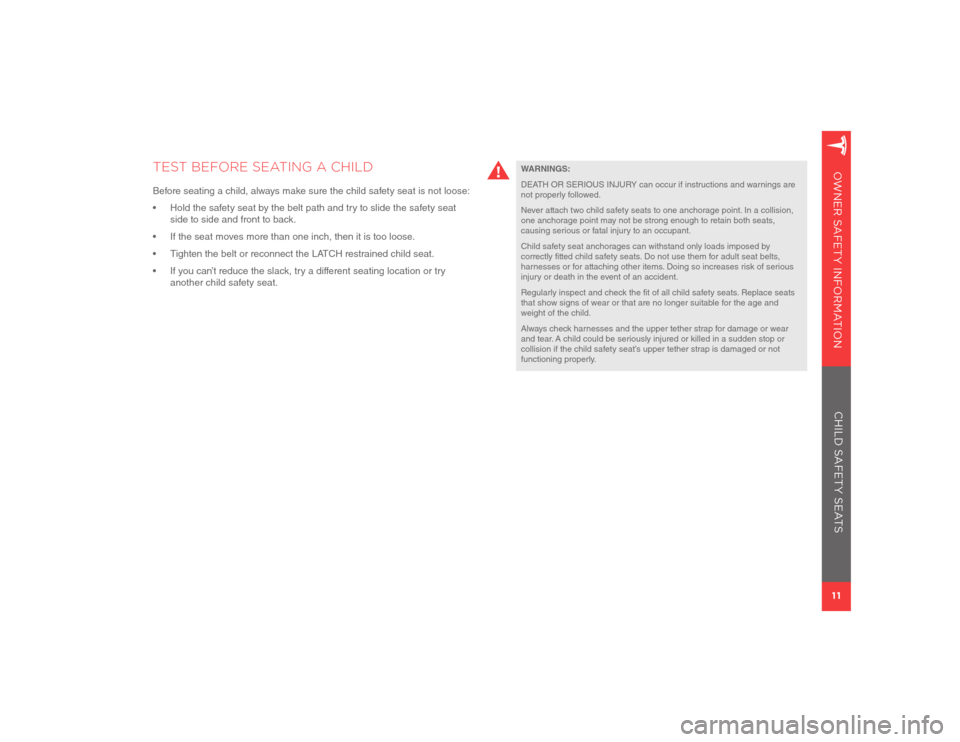
11OWNER SAFETY INFORMATION
WARNINGS:
DEATH OR SERIOUS INJURY can occur if instructions and warnings are
not properly followed.
Never attach two child safety seats to one anchorage point. In a collision,
one anchorage point may not be strong enough to retain both seats,
causing serious or fatal injury to an occupant.
Child safety seat anchorages can withstand only loads imposed by
correctly fitted child safety seats. Do not use them for adult seat belts,
harnesses or for attaching other items. Doing so increases risk of serious
injury or death in the event of an accident.
Regularly inspect and check the fit of all child safety seats. Replace seats
that show signs of wear or that are no longer suitable for the age and
weight of the child.
Always check harnesses and the upper tether strap for damage or wear
and tear. A child could be seriously injured or killed in a sudden stop or
collision if the child safety seat’s upper tether strap is damaged or not
functioning properly.
CHILD SAFETY SEATS
TEST BEFORE SEATING A CHILDBefore seating a child, always make sure the child safety seat is not loose:
• Hold the safety seat by the belt path and try to slide the safety seat
side to side and front to back.
• If the seat moves more than one inch, then it is too loose.
• Tighten the belt or reconnect the LATCH restrained child seat.
• If you can’t reduce the slack, try a different seating location or try
another child safety seat.
Page 14 of 28
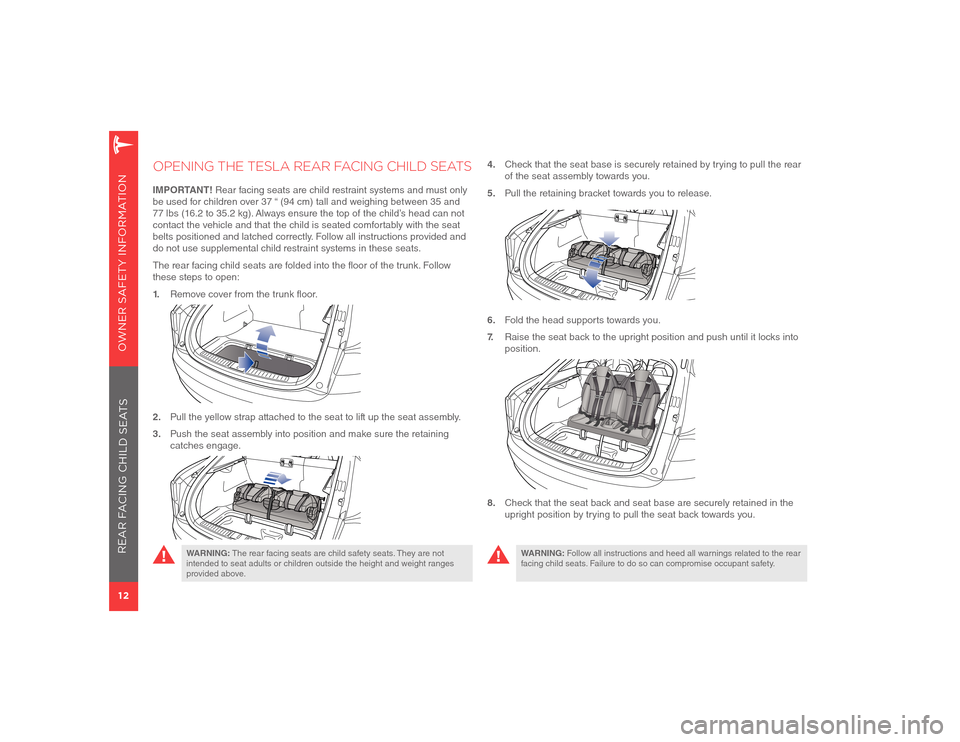
12OWNER SAFETY INFORMATIONREAR FACING CHILD SEATS
OPENING THE TESLA REAR FACING CHILD SEATSIMPORTANT! Rear facing seats are child restraint systems and must only
be used for children over 37 “ (94 cm) tall and weighing between 35 and
77 lbs (16.2 to 35.2 kg). Always ensure the top of the child’s head can not
contact the vehicle and that the child is seated comfortably with the seat
belts positioned and latched correctly. Follow all instructions provided and
do not use supplemental child restraint systems in these seats.
The rear facing child seats are folded into the floor of the trunk. Follow
these steps to open:
1. Remove cover from the trunk floor.2. Pull the yellow strap attached to the seat to lift up the seat assembly.
3. Push the seat assembly into position and make sure the retaining
catches engage.
4. Check that the seat base is securely retained by trying to pull the rear
of the seat assembly towards you.
5. Pull the retaining bracket towards you to release.6. Fold the head supports towards you.
7. Raise the seat back to the upright position and push until it locks into
position.8. Check that the seat back and seat base are securely retained in the
upright position by trying to pull the seat back towards you.
WARNING: The rear facing seats are child safety seats. They are not
intended to seat adults or children outside the height and weight ranges
provided above.
WARNING: Follow all instructions and heed all warnings related to the rear
facing child seats. Failure to do so can compromise occupant safety.
Page 15 of 28
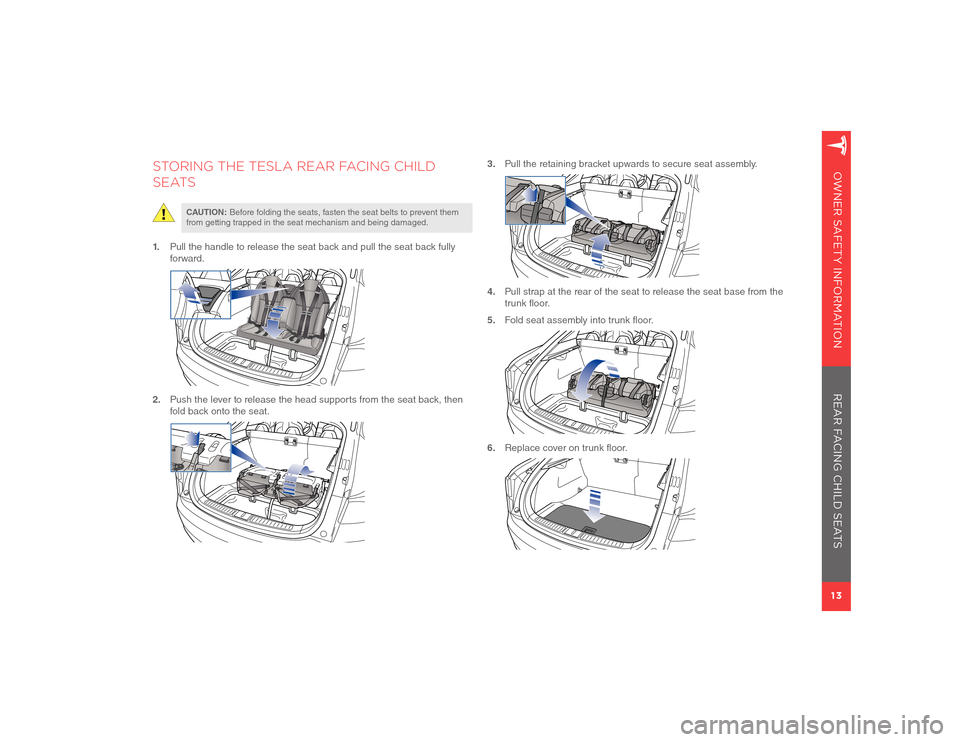
13OWNER SAFETY INFORMATION
STORING THE TESLA REAR FACING CHILD
SEATS
CAUTION:
Before folding the seats, fasten the seat belts to prevent them
from getting trapped in the seat mechanism and being damaged.
1. Pull the handle to release the seat back and pull the seat back fully
forward.2. Push the lever to release the head supports from the seat back, then
fold back onto the seat.
3. Pull the retaining bracket upwards to secure seat assembly.4. Pull strap at the rear of the seat to release the seat base from the
trunk floor.
5. Fold seat assembly into trunk floor.6. Replace cover on trunk floor.
REAR FACING CHILD SEATS
Page 16 of 28

14OWNER SAFETY INFORMATIONREAR FACING CHILD SEATS
SEATING A CHILD IN THE TESLA REAR FACING CHILD SEATS
WARNING: The rear facing seats are child safety seats. They must only be used for children over 37 “ (94 cm) tall and weighing between 35 and 77 lbs (16.2
to 35.2 kg). Ensure the top of the child’s head can not contact the vehicle. Do not use supplemental child restraint systems in these seats. Follow all instructions
provided.
Releasing1. Release the seat belts by
pressing the button on the buckle.
2. Release the chest clip.
3. Separate the two halves of the
seat restraint.
Fastening1. Position the child in the
seat with arms through the
loops of the seat belts.
2. Connect the two halves
of the seat belt and latch
together.
3. Insert the seat belt tongue
latch into the buckle
and ensure it is securely
fastened.
4. Adjust the shoulder belts so that they run over the top of the child’s
shoulders and away from the face.
5. Connect the chest clip.
6. Pull the lower straps until the child is securely held in the seat.
Page 17 of 28

15OWNER SAFETY INFORMATION
BRAKING SYSTEMSModel S is equipped with an anti-lock braking system (ABS) that prevents
the wheels from locking when you apply maximum brake pressure. This
allows you to maintain steering control during heavy braking on most road
conditions.
During emergency braking conditions, the ABS constantly monitors the
speed of each wheel and varies the brake pressure according to the
grip available. The alteration of brake pressure can be felt as a pulsing
sensation through the brake pedal. This demonstrates that ABS is
operating and is no cause for concern. Keep firm and steady pressure on
the brake pedal while experiencing the pulsation.
Model S continuously monitors its brake systems and alerts you if a fault is
detected:
An ABS fault is detected. The brakes remain fully
operational and are not affected by an ABS failure.
However, braking distances may increase and wheels
may lock under heavy braking. Contact Tesla.A brake system fault is detected or the brake fluid
level is low. Contact Tesla immediately.
BRAKE WEARModel S brake pads are equipped with wear indicators. A wear indicator is
a thin metal strip attached to the brake pad that squeals as it rubs against
the rotor when the pad wears down. This squealing sound serves as a
reminder that you need to replace your brake pads. To stop the squealing,
contact Tesla to have your brakes inspected, and if necessary to have new
brake pads installed. If you don’t replace the brake pads, you will soon
hear a grinding sound. This metal on metal grinding can damage your
braking system, and in turn, create a braking hazard.
WARNINGS:
In an emergency, fully press the brake pedal. DO NOT pump the brake
pedal. ABS does this for you and by pumping the foot brake yourself, you
interfere with ABS operation, which can increase braking distance.
Contact Tesla if the movement of the brake pedal has increased, or if you
notice a significant loss of brake fluid. Driving under such conditions could
result in extended stopping distances or complete brake failure.
BRAKING SYSTEM
Page 18 of 28

16OWNER SAFETY INFORMATION
CHECK THESE LABELSTwo labels on the driver’s door pillar provide important tire pressure and
vehicle loading information.
1
2
1. TIRE AND LOADING INFORMATION
Specifies tire pressures (see page 17) and the maximum load your
vehicle can carry (see page 23).
2. VEHICLE CERTIFICATION
• GVWR - Gross Vehicle Weight Rating. The maximum allowable
total mass of the vehicle. This is calculated as the weight of the
vehicle, all passengers, fluids, and cargo.
• GAWR FR and GAWR RR - Gross Axle Weight Rating for the
front and rear axles. The maximum distributed weight that may be
supported by each axle.
TIRE PRESSURES
Page 19 of 28
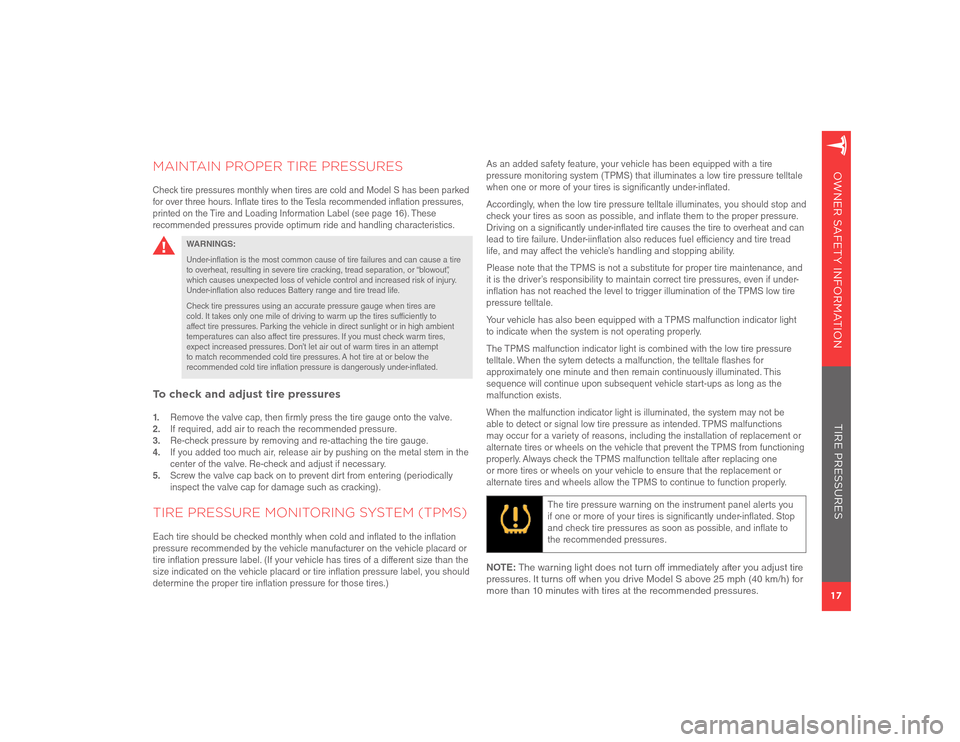
17OWNER SAFETY INFORMATION
MAINTAIN PROPER TIRE PRESSURESCheck tire pressures monthly when tires are cold and Model S has been parked
for over three hours. Inflate tires to the Tesla recommended inflation pressures,
printed on the Tire and Loading Information Label (see page 16). These
recommended pressures provide optimum ride and handling characteristics.
WARNINGS:Under-inflation is the most common cause of tire failures and can cause a tire
to overheat, resulting in severe tire cracking, tread separation, or “blowout”,
which causes unexpected loss of vehicle control and increased risk of injury.
Under-inflation also reduces Battery range and tire tread life.
Check tire pressures using an accurate pressure gauge when tires are
cold. It takes only one mile of driving to warm up the tires sufficiently to
affect tire pressures. Parking the vehicle in direct sunlight or in high ambient
temperatures can also affect tire pressures. If you must check warm tires,
expect increased pressures. Don’t let air out of warm tires in an attempt
to match recommended cold tire pressures. A hot tire at or below the
recommended cold tire inflation pressure is dangerously under-inflated.
To check and adjust tire pressures1. Remove the valve cap, then firmly press the tire gauge onto the valve.
2. If required, add air to reach the recommended pressure.
3. Re-check pressure by removing and re-attaching the tire gauge.
4. If you added too much air, release air by pushing on the metal stem in the
center of the valve. Re-check and adjust if necessary.
5. Screw the valve cap back on to prevent dirt from entering (periodically
inspect the valve cap for damage such as cracking).TIRE PRESSURE MONITORING SYSTEM (TPMS)Each tire should be checked monthly when cold and inflated to the inflation
pressure recommended by the vehicle manufacturer on the vehicle placard or
tire inflation pressure label. (If your vehicle has tires of a different size than the
size indicated on the vehicle placard or tire inflation pressure label, you should
determine the proper tire inflation pressure for those tires.)As an added safety feature, your vehicle has been equipped with a tire
pressure monitoring system (TPMS) that illuminates a low tire pressure telltale
when one or more of your tires is significantly under-inflated.
Accordingly, when the low tire pressure telltale illuminates, you should stop and
check your tires as soon as possible, and inflate them to the proper pressure.
Driving on a significantly under-inflated tire causes the tire to overheat and can
lead to tire failure. Under-iinflation also reduces fuel efficiency and tire tread
life, and may affect the vehicle’s handling and stopping ability.
Please note that the TPMS is not a substitute for proper tire maintenance, and
it is the driver’s responsibility to maintain correct tire pressures, even if under-
inflation has not reached the level to trigger illumination of the TPMS low tire
pressure telltale.
Your vehicle has also been equipped with a TPMS malfunction indicator light
to indicate when the system is not operating properly.
The TPMS malfunction indicator light is combined with the low tire pressure
telltale. When the sytem detects a malfunction, the telltale flashes for
approximately one minute and then remain continuously illuminated. This
sequence will continue upon subsequent vehicle start-ups as long as the
malfunction exists.
When the malfunction indicator light is illuminated, the system may not be
able to detect or signal low tire pressure as intended. TPMS malfunctions
may occur for a variety of reasons, including the installation of replacement or
alternate tires or wheels on the vehicle that prevent the TPMS from functioning
properly. Always check the TPMS malfunction telltale after replacing one
or more tires or wheels on your vehicle to ensure that the replacement or
alternate tires and wheels allow the TPMS to continue to function properly.
The tire pressure warning on the instrument panel alerts you
if one or more of your tires is significantly under-inflated. Stop
and check tire pressures as soon as possible, and inflate to
the recommended pressures
.
NOTE: The warning light does not turn off immediately after you adjust tire
pressures. It turns off when you drive Model S above 25 mph (40 km/h) for
more than 10 minutes with tires at the recommended pressures.
TIRE PRESSURES
Page 20 of 28
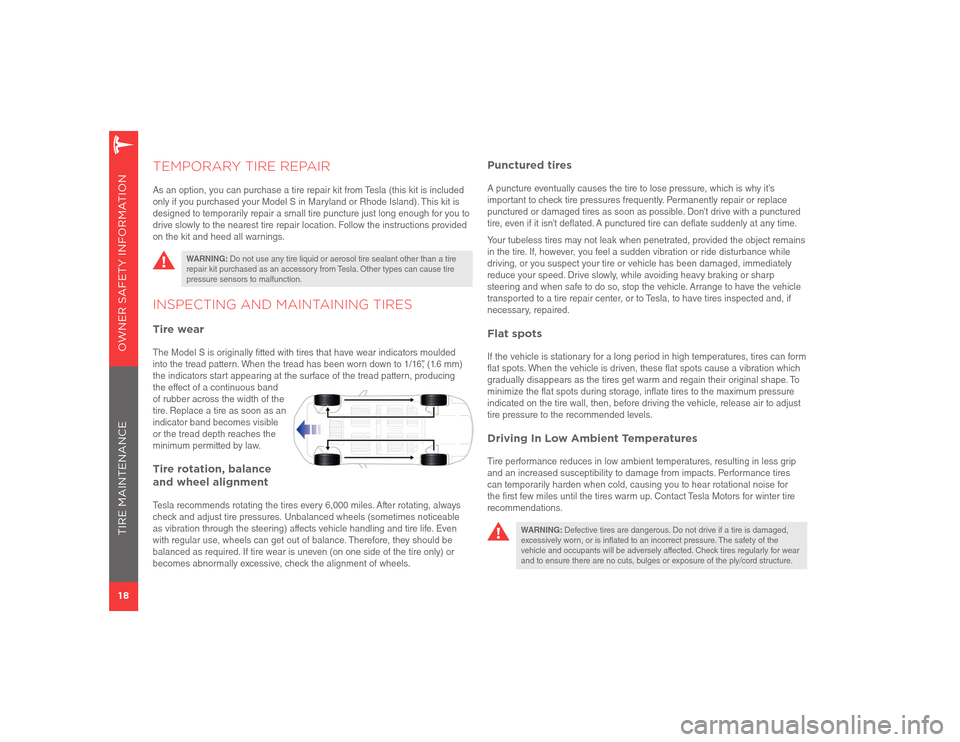
18OWNER SAFETY INFORMATION
Punctured tiresA puncture eventually causes the tire to lose pressure, which is why it’s
important to check tire pressures frequently. Permanently repair or replace
punctured or damaged tires as soon as possible. Don’t drive with a punctured
tire, even if it isn’t deflated. A punctured tire can deflate suddenly at any time.
Your tubeless tires may not leak when penetrated, provided the object remains
in the tire. If, however, you feel a sudden vibration or ride disturbance while
driving, or you suspect your tire or vehicle has been damaged, immediately
reduce your speed. Drive slowly, while avoiding heavy braking or sharp
steering and when safe to do so, stop the vehicle. Arrange to have the vehicle
transported to a tire repair center, or to Tesla, to have tires inspected and, if
necessary, repaired. Flat spotsIf the vehicle is stationary for a long period in high temperatures, tires can form
flat spots. When the vehicle is driven, these flat spots cause a vibration which
gradually disappears as the tires get warm and regain their original shape. To
minimize the flat spots during storage, inflate tires to the maximum pressure
indicated on the tire wall, then, before driving the vehicle, release air to adjust
tire pressure to the recommended levels. Driving In Low Ambient TemperaturesTire performance reduces in low ambient temperatures, resulting in less grip
and an increased susceptibility to damage from impacts. Performance tires
can temporarily harden when cold, causing you to hear rotational noise for
the first few miles until the tires warm up. Contact Tesla Motors for winter tire
recommendations.
WARNING: Defective tires are dangerous. Do not drive if a tire is damaged,
excessively worn, or is inflated to an incorrect pressure. The safety of the
vehicle and occupants will be adversely affected. Check tires regularly for wear
and to ensure there are no cuts, bulges or exposure of the ply/cord structure.
TEMPORARY TIRE REPAIRAs an option, you can purchase a tire repair kit from Tesla (this kit is included
only if you purchased your Model S in Maryland or Rhode Island). This kit is
designed to temporarily repair a small tire puncture just long enough for you to
drive slowly to the nearest tire repair location. Follow the instructions provided
on the kit and heed all warnings.
WARNING: Do not use any tire liquid or aerosol tire sealant other than a tire
repair kit purchased as an accessory from Tesla. Other types can cause tire
pressure sensors to malfunction.
INSPECTING AND MAINTAINING TIRESTire wearThe Model S is originally fitted with tires that have wear indicators moulded
into the tread pattern. When the tread has been worn down to 1/16”, (1.6 mm)
the indicators start appearing at the surface of the tread pattern, producing
the effect of a continuous band
of rubber across the width of the
tire. Replace a tire as soon as an
indicator band becomes visible
or the tread depth reaches the
minimum permitted by law.Tire rotation, balance
and wheel alignmentTesla recommends rotating the tires every 6,000 miles. After rotating, always
check and adjust tire pressures.
Unbalanced wheels (sometimes noticeable
as vibration through the steering) affects vehicle handling and tire life. Even
with regular use, wheels can get out of balance. Therefore, they should be
balanced as required. If tire wear is uneven (on one side of the tire only) or
becomes abnormally excessive, check the alignment of wheels.
TIRE MAINTENANCE